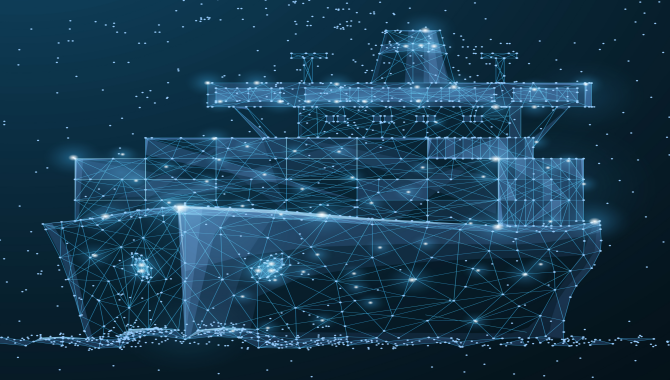Kenworthy, who witnessed the introduction of satellite communications while in the Merchant Navy, came ashore and worked with Marinet Systems before establishing GTMaritime and developing ship-specific email software. Fast forward and – today – GTMaritime's maritime email and data communications software is installed on over 12,000 vessels worldwide.
Given the background, Kenworthy's views on the digital roadblocks facing shipping are clearly worth a listen. "There are massive opportunities, but with this come some serious challenges," he says.
"In my days at sea, we had a single terminal for telex over high frequency radio, sending a noon report once a day. There were very little communications and little to attack from a cyber security perspective. However, in today's environment there is a drive to connect everything."
Malware and cybersecurity issues are among the biggest challenges facing shipping. Ensuring crew training is up to date and that best practices are being adhered to on remote ships is extremely difficult, says Kenworthy. Making sure shipboard software products are up to date can be even more challenging.
Providing shipowners with secure maritime communications solutions remains a priority for GTMaritime, and Kenworthy offers some sobering figures to demonstrate the scale of the task.
"Email is often seen as an easy attack vector from both a technology and social engineering perspective. At GTMaritime we implement multiple layers of security from standard email hygiene checks that include spam and AV checks, through to behavioural analysis to identify unknown threats. Worryingly, we discover and stop around 31,000 of these unknown threats each month. That's over 1,000 items a day."
Threats continue to be on the rise, meaning that GTMaritime is continuously and intensively developing upgraded and new products to combat advanced malware and phishing detection.
"We keep the cybersecurity landscape under constant review to ensure we are providing our customers with the highest levels of protection," says Kenworthy. "Technology solutions to detect threats are only one piece of the puzzle though; we therefore offer training and phishing tests free of charge to our customers to support crew competence. Meanwhile, our GTDeploy solution ensures software onboard is continuously updated, with the ability to deliver, install and report on Windows updates coming soon."
The massive amount of data now being transmitted to and from ships will only continue to increase, the GTMaritime CEO notes. Ship performance monitoring and big data will play a key role in addressing industry challenges, such as decarbonisation; investment in new technologies which can improve ship operations and gather data to aid decision making shows no signs of slowing.
"The digitalisation bubble is expanding and is starting to drive massive changes. Already I can see ports are becoming more connected to each other and talking about digitalisation so that ships can truly operate in the 'just in time manner'. This will be a big change for shipping," says Kenworthy.
Reality check
While owners may opt for connectivity agreements which separate operational and crew communications, a recent report from Inmarsat shows that 70-80% of the available data is being consumed by crew wishing to stay connected with friends and family while at sea. This has consequences for available bandwidth.
"There is significant demand for bandwidth onboard ships now, with ships transmitting and receiving huge amounts of data but the majority are not coping well," Kenworthy comments. "There are a few factors at play here. For example, the VSAT terminals that were installed a few years ago do not have a tremendous amount of bandwidth, and installing a higher-powered satellite terminal with higher bandwidth or investing in a higher bandwidth plan might not always be the most cost-effective solutions. Shipowners and managers also need to consider that bandwidth capacity varies in certain regions and the maximum bandwidth that a vessel receives will often be different from what they experience, especially if there are multiple vessels and people trying to use the same data connection at the same time."
With third parties such as engine manufactures, ECDIS operators and charterers – among others – driving greater data usage, pressure is mounting on shipowners to consider higher bandwidth packages or risk all data communications grinding to a halt during file transfers.
"All-you-can-eat-data packages are all very well, but the speed needs to increase to cope with demand. If a ship has standard VSAT with average bandwidth, it can quickly clog up its connection unless a data compression application is installed. GTReplicate, for example, allows IT managers to configure, monitor and execute simultaneous file transfers from a central location providing greater control and visibility."
Using GTMaritime's secure FastNet data transfer platform, GTReplicate helps to bridge the gap between supply and demand in a ship's bandwidth by managing the data pipeline, says Kenworthy. It prioritises data by allocating bandwidth to tasks to ensure there is still enough bandwidth for other tasks – allowing emails to continue being sent and received during large file transfers. Tasks can also be automated and GTReplicate compresses data, in addition, if the connection drops, it will restart from the point of interruption.
GTReplicate has found a ready audience among shipping IT managers for its ability to configure, monitor and execute simultaneous file transfer tasks from a central location, he adds. The package was recently updated to allow integration with SharePoint - the first step towards providing full cloud storage integration at sea.
The opinions expressed herein are the author's and not necessarily those of The Xinde Marine News.
Please Contact Us at:
media@xindemarine.com



 Ningbo Containerized Freight Index Weekly Commentar
Ningbo Containerized Freight Index Weekly Commentar  Ningbo Containerized Freight Index Weekly Commentar
Ningbo Containerized Freight Index Weekly Commentar  Ningbo Containerized Freight Index Weekly Commentar
Ningbo Containerized Freight Index Weekly Commentar  BIMCO Shipping Number of the Week: Bulker newbuildi
BIMCO Shipping Number of the Week: Bulker newbuildi  Ningbo Containerized Freight Index Weekly Commentar
Ningbo Containerized Freight Index Weekly Commentar  Ningbo Containerized Freight Index Weekly Commentar
Ningbo Containerized Freight Index Weekly Commentar